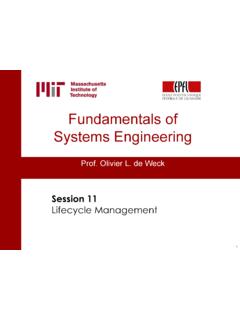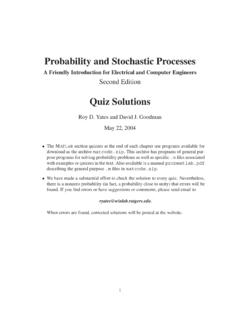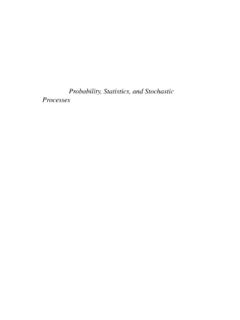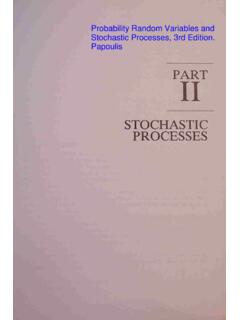Transcription of Stochastic Processes and Brownian Motion
1 Chapter 1 Stochastic Processes and Brownian Motion Equilibrium thermodynamics and statistical mechanics are widely considered to be core subject matter for any practicing chemist [1]. There are plenty of reasons for this: A great many chemical phenomena encountered in the laboratory are well described by equi librium thermodynamics. The physics of chemical systems at equilibrium is generally well understood and mathemati cally tractable. Equilibrium thermodynamics motivates our thinking and understanding about chemistry away from equilibrium.
2 This last point, however, raises a serious question: how well does equilibrium thermodynamics really motivate our understanding of nonequilibrium phenomena? Is it reasonable for an organometallic chemist to analyze a catalytic cycle in terms of rate-law kinetics, or for a biochemist to treat the concentration of a solute in an organelle as a bulk mixture of compounds? Under many circum stances, equilibrium thermodynamics suffices, but a growing number of outstanding problems in chemistry from electron transfer in light-harvesting complexes to the chemical mechanisms behind immune system response concern Processes that are fundamentally out of equilibrium.
3 This course endeavors to introduce the key ideas that have been developed over the last century to describe nonequilibrium phenomena. These ideas are almost invariably founded upon a statistical description of matter, as in the equilibrium case. However, since nonequilibrium phenomena con tain a more explicit time-dependence than their equilibrium counterparts (consider, for example, the decay of an NMR signal or the progress of a reaction), the probabilistic tools we develop will require some time-dependence as well. In this chapter, we consider systems whose behavior is inherently nondeterministic, or stochas tic, and we establish methods for describing the probability of finding the system in a particular state at a specified time.
4 1 2 Chapter 1. Stochastic Processes and Brownian Motion Markov Processes probability Distributions and Transitions Suppose that an arbitrary system of interest can be in any one of N distinct states. The system could be a protein exploring different conformational states; or a pair of molecules oscillating be tween a reactants state and a products state; or any system that can sample different states over time. Note here that N is finite, that is, the available states are discretized. In general, we could consider systems with a continuous set of available states (and we will do so in section ), but for now we will confine ourselves to the case of a finite number of available states.
5 In keeping with our discretization scheme, we will also (again, for now) consider the time evolution of the system in terms of discrete timesteps rather than a continuous time variable. Let the system be in some unknown state m at timestep s, and suppose we re interested in the probability of finding the system in a specific state n, possibly but not necessarily the same as state m, at the next timestep s + 1. We will denote this probability by P (n, s + 1) If we had knowledge of m, then this probability could be described as the probability of the system being in state n at timestep s + 1 given that the system was in state m at timestep s.
6 Probabilities of this form are known as conditional probabilities, and we will denote this conditional probability by Q(m, s | n, s + 1) In many situations of physical interest, the probability of a transition from state m to state n is time-independent, depending only on the nature of m and n, and so we drop the timestep arguments to simplify the notation, Q(m, s | n, s + 1) Q(m, n) This observation may seem contradictory, because we are interested in the time-dependent proba bility of observing a system in a state n while also claiming that the transition probability described above is time-independent.
7 But there is no contradiction here, because the transition probability Q a conditional probability is a different quantity from the time-dependent probability P we are interested in. In fact, we can express P (n, s+1) in terms of Q(m, n) and other quantities as follows: Since we don t know the current state m of the system, we consider all possible states m and multiply the probability that the system is in state m at timestep s by the probability of the system being in state n at timestep s+1 given that it is in state m at timestep s.
8 Summing over all possible states m gives P (n, s1) at timestep s + 1 in terms of the corresponding probabilities at timestep s. Mathematically, this formulation reads P (n, s + 1) = P (m, s)Q(m, n) ( ) m We ve made some progress towards a practical method of finding P (n, s+1), but the current formu lation Eq.( ) requires knowledge of both the transition probabilities Q(m, n) and the probabilities , Spring 2008 J. Cao 3 Chapter 1. Stochastic Processes and Brownian Motion P (m, s) for all states m. Unfortunately, P (m, s) is just as much a mystery to us as P (n, s + 1).
9 What we usually know and control in experiments are the initial conditions; that is, if we prepare the system in state k at timestep s = 0, then we know that P (k, 0) = 1 and P (n, 0) = 0 for all n So how do we express P (n, s + 1) in terms of the initial conditions of the experiment? = k. We can proceed inductively: if we can write P (n, s + 1) in terms of P (m, s), then we can also write P (m, s) in terms of P (l, s 1) by the same approach: P (n, s + 1) = P (l, s 1)Q(l, m)Q(m, n) ( ) l,m Note that Q has two parameters, each of which can take on N possible values.
10 Consequently we may choose to write Q as an N N matrix Q with matrix elements (Q)mn = Q(m, n). Rearranging the sums in Eq.( ) in the following manner, P (n, s + 1) = P (l, s 1) Q(l, m)Q(m, n) ( ) lm we recognize the sum over m as the definition of a matrix product, (Q)lm(Q)mn = (Q2)ln ( ) m Hence, Eq.( ) can be recast as P (n, s + 1) = P (l, s 1)(Q2)ln ( ) l This process can be continued inductively until P (n, s + 1) is written fully in terms of initial conditions. The final result is: P (n, s + 1) = P (m, 0)(Qs+1)mn ( ) m = P (k, 0)(Qs+1)mn ( ) where k is the known initial state of the system (all other m do not contribute to the sum since P (m, 0) = k).



















